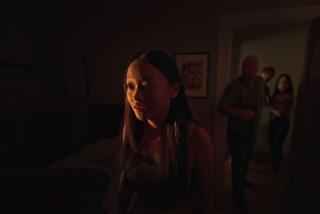For filmmaker Godfrey Reggio, ‘Visitors’ feels like home
American filmmakers have tried some neat formal tricks lately — think J.C. Chandor and the frantic silence of “All Is Lost” — but few have the brio Godfrey Reggio displays in his new work “Visitors.”
The black-and-white film, which is just wrapping a three-week theatrical run in Los Angeles before heading to VOD this spring, continues the director’s pattern of experimental documentary.
Focusing on faces, largely though not strictly human, as well as assorted other images, “Visitors” is essentially a montage set to music (a Philip Glass score), with no narrative and few obvious transitions. If that doesn’t quite give you a sense of what the film is, it’s because, well, a movie this abstract doesn’t really lend itself to description.
Basically, “Visitors” straddles the line between art piece, film and meditation exercise as its slow-burn images invite and challenge the viewer to all manner of contemplation — which is pretty much how Reggio intended it.
PHOTOS: Behind the scenes of movies and TV
“The whole premise of the film is the audience watching the film,” said Reggio, the New Orleans filmmaker best known for his experimental Qatsi trilogy that explores the relationship between man, nature and technology. “You’re looking at a screen, but what’s not so obvious is the screen is looking at you.” In large part, he explained, that’s because many of the faces are themselves looking at an (unseen) screen.
In “Visitors,” the camera will often seem to train itself on a subject and slowly zero in, so that if there are changes in the images, they are perceived slowly. As that unfolds, viewers are likely to find their minds wandering, thinking not just of the images but existential questions — or, for that matter, mundane ones.
Steven Soderbergh, who executive produced the movie, called the film “interactive in a way that’s totally unique in moviegoing,” adding, “Usually it’s the worst thing in the world for someone to be watching your movie and thinking about something else. But that’s the whole point of this. The whole pleasure is riffing on the movie while you’re watching the movie.”
If “Visitors” — the title suggests we are all just passing through, though even that theme is oblique — has a meditative quality, Reggio’s interpretations are fully voluble. Citing his Christian influences, the 74-year-old director noted the maxim “That which is most present is that which is least seen,” and thus it followed that “If you really want to see something for the first time you must stare at it until it becomes strange.”
PHOTOS: Box office top 10 of 2013
And there is plenty of strange here. Faces can become disembodied hands, morph into abandoned amusement park rides, then back to faces again.
The aesthetic is hardly to everyone’s taste. Writing in The Times, Kennth Turan said, “It all sounds quite convincing in theory, but in practice this mélange of imagery is aimed more at the inside of Reggio’s head than anywhere else,” adding tartly that the film is likely to “put you right to sleep.”
One can hear his argument, though many of those images are compelling. At a Toronto International Film Festival screening Glass conducted a live orchestra playing the score, and at a rehearsal, as Glass gave direction to the dozens of musicians in the orchestra pit, some of them could be seen sneaking glances up at the screen, the giant, at times whimsical images holding their eye.
Even its detractors might note the bravado Reggio shows, and his belief that cinema is something to experience as much as watch.
Or as the director said. “The beauty of art it has no intrinsic meaning.”
ALSO:
John Travolta beating himself up over Oscars flub
Oscars: From J-Law to French animators, decoding five strange moments
Follow me on Twitter at @ZeitchikLAT
More to Read
Only good movies
Get the Indie Focus newsletter, Mark Olsen's weekly guide to the world of cinema.
You may occasionally receive promotional content from the Los Angeles Times.







